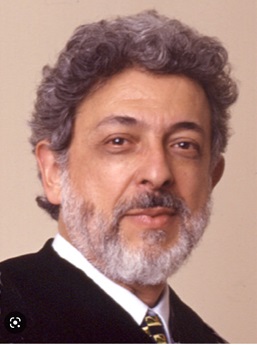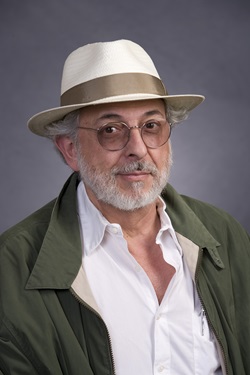| We are very saddened by the sudden passing of our long-time colleague
and former chair, Eduardo Macagno, who died on September 25. Eduardo
was born in 1943 in Argentina and moved with his parents and sister
Laura to the University of Iowa in Iowa City in 1956, where his father,
Enzo, was a professor of fluid mechanics and his mother, Matilde, was a
professor of mathematics. It was here that Eduardo began his love of
classical music and learned to play the bass and cello. After
receiving his Ph.D. in physics, working with the renowned physicist
Madam Chien-Shiung Wu at Columbia University in 1968, he changed fields
and began working in neurobiology as a postdoctoral researcher with
Cyrus Levinthal in the Department of Biological Sciences at Columbia.
He established his own laboratory there in 1973 and rose through the
ranks to become a full professor in 1985 and Columbia’s departmental
chair from 1991 to 1993. From 1993 to 2000 he served as Associate Vice
President for Research and Graduate Education and Dean of the Graduate
School of Arts and Sciences at Columbia. In 2001 he moved to the
University of California at San Diego to become the Founding Dean of
the School of Biological Sciences. |

|
| Eduardo’s research centered on the development of the nervous system
and the intricate interplay of the neurons that form it, first using
the water flea Daphnia magna and then the medicinal leech, Hirudo
medicinalis. He was one of the first people to use serial-section
electron microscopy to analyze nervous system development and
circuitry, what is now referred to as connectomics. In these studies,
he discovered "pioneer fibers" which, in Daphnia, were the first cells
to form the optic nerve, enabling other cells to follow; when he
ablated the pioneer early in development, he found that another axon
could take over its role. He then studied the mechanisms underlying
neuronal growth, concentrating on the function of receptor phosphatases
in growth-cone navigation and target selection and on neuronal
self-recognition. His discoveries using the leech include that
neurogenesis (as opposed to just neuron death) is controlled by
peripheral targets, successfully regenerating sensory fibers that use
glycoproteins to find the pathways to their targets in the central
nervous system. In addition, he found that the specificity of
electrical synapses is controlled in part by the selective expression
of particular gap-junctional proteins. This research on the neural
development of simple systems was recognized with one of the first
Jacob Javits Neuroscience Investigator Awards from the National
Institutes of Health, and by Eduardo’s election in 1992 as a Fellow of
the American Association for the Advancement of Science. Steven
Siegelbaum, the current chair of the Department of Neuroscience at
Columbia, has said about Eduardo, “He was a true pioneer of
developmental neuroscience at Columbia.” | Eduardo was a major contributor to the field of neurodevelopment not
only through his own research, but also, until 2020, as the
Editor-in-Chief of the journal, Developmental Neurobiology. In
addition, he mentored over 40 graduate students and postdocs and
numerous undergraduates, and taught Columbia’s undergraduate course in
physiology. From 1980 to 1994, he was an instructor in the Neural
Systems and Behavior course at the Marine Biological Laboratory at
Woods Hole, which he co-directed with Ron Hoy (Cornell) in 1983 and
1984. He also taught in MBL’s leech course, Neurobiology of the Leech,
which was also the very first course Eduardo took after switching from
physics to biology.
During
his time at UCSD, he continued to study the cellular and
molecular mechanisms underlying neuronal identity, the generation of
neuronal arbors, synaptic target selection, and formation of neuronal
circuits. In addition, he and his collaborators characterized the H.
medicinalis genome and transcriptome, which was put in the public
domain. In the last several years, he embarked on a new path, and
pioneered the creation of a new interdisciplinary field at the nexus of
Architecture and Neuroscience; in 2003, he co-founded the
Academy of
|  | Neuroscience for Architecture, dedicated to improving human-centered
architectural design by furthering the understanding of how the human
brain processes information as it experiences the built environment. He
was ANFA’s President from 2009-2011 and, in recent years, he and his
international collaborators used detailed behavioral analyses,
3D-immersive virtual reality, and wearable sensors to assay human
responses while navigating the built environment, focusing on people
experiencing visual and/or cognitive impairment.
Eduardo is survived by his loving family: his wife and colleague, Laura
Wolszon; their adult children, Francesco and Lucia Macagno; his sister,
Laura Macagno-Shang; his nieces, Camille and Natalie Montilino and
Jamie Wolszon; and his nephews, Sidney Payne and Joshua Wolszon. | 
Photo credit: Laura Wolszon | "This
is heartbreaking for me. Eduardo Macagno's wife (Laura) called me
today to give me the sad news that Eduardo Macagno died suddenly on
Sept. 25, 2023 of a sudden heart aneurism. Eduardo was one of my
closest friends from 1958 onward.
He was a brilliant scholar and a Full Professor at U-C San Diego. I am honored that I wrote my | 
Eduardo & his wife, Laura |
| recommendation
that got him inducted into the Iowa City High School Hall of
Fame. Nobody ever deserved that honor more than he did.
Eduardo and I got together regularly for many years. He loved ice
hockey and played on the hockey team at Columbia University in New York
City. He and I attended many of the Anaheim Ducks hockey games;
and we attended many of the San Diego Gulls hockey games in San Diego.
We also attended together at San Diego Padres baseball games and San
Diego Chargers football games (until the Chargers moved to Los Angeles)
I never had a better friend than Eduardo Macagno and I will miss him terribly. I will offer a Mass for him tomorrow."
AL SCHALLAU |
|

